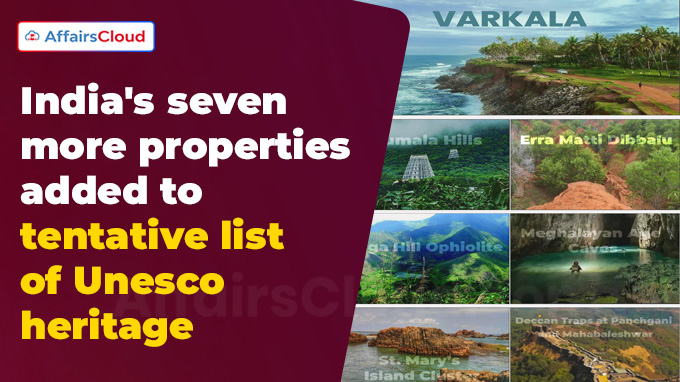 In September 2025, the Permanent Delegation of India to United Nations Educational, Scientific and Cultural Organisation (UNESCO) announced the inclusion of 7 Indian properties/sites under the ‘Natural Category’ in the Tentative List of UNESCO’s World Heritage Convention
In September 2025, the Permanent Delegation of India to United Nations Educational, Scientific and Cultural Organisation (UNESCO) announced the inclusion of 7 Indian properties/sites under the ‘Natural Category’ in the Tentative List of UNESCO’s World Heritage Convention
- With this, the total number of Indian sites on the list increases to 69, including 49 under Cultural category, 3 under Mixed Category and 17 under Natural Category.
Exam Hints:
- What? Inclusion of 7 Indian Properties in UNESCO’s Tentative List
- Announced by: Permanent Delegation of India to UNESCO
- Category: Natural
- Total Indian Sites: 69 including 49 (Cultural Category), 3 (Mixed category) and 17 (Natural category)
- Sites Name: Deccan Traps at Panchgani and Mahabaleshwar (Maharashtra); Geological Heritage of St. Mary’s Island Cluster (Karnataka); Meghalayan Age Caves (Meghalaya); Naga Hill Ophiolite (Nagaland); Natural Heritage of Erra Matti Dibbalu (AP); Natural Heritage of Tirumala Hills (AP) and Natural Heritage of Varkala (Kerala)
- India’s UNESCO World Heritage Sites: 44(as of July 2025)
Name of 7 Newly added Indian Sites:
| Name of the Property | Region/State |
|---|---|
| Deccan Traps at Panchgani and Mahabaleshwar | Maharashtra |
| Geological Heritage of St. Mary’s Island Cluster | Udupi, Karnataka |
| Meghalayan Age Caves | East Khasi Hills, Meghalaya |
| Naga Hill Ophiolite | Kiphire, Nagaland |
| Natural Heritage of Erra Matti Dibbalu | Visakhapatnam, Andhra Pradesh (AP) |
| Natural Heritage of Tirumala Hills | Tirupati, AP |
| Natural Heritage of Varkala | Kerala |
About UNESCO’s Tentative List:
Tentative List: It is an inventory of properties that a country considers for nomination to the UNESCO World Heritage List(WHL).
- The list comprises of sites that can be either cultural or natural areas or objects for having outstanding universal value.
Significance: As per UNCESCO rules, it is mandatory to be added to the tentative list before the inscription of any property on the WHL.
Conditions: State Parties are required to ensure that their respective tentative list should not be considered exhaustive, to the World Heritage Centre (WHC) at least one year prior to the submission of any nomination.
Periodic Revisions: UNESCO encouraged the State Parties to re-examine and re-submit their tentative list at least every 10 years.
Indian Sites on WHL: As of July 2025, India has 44 properties inscribed on the UNESCO WHL, categorized as Cultural Sites (36), Natural Sites (7) and Mixed Site (1- Khangchendzonga National Park, NP in Sikkim).
- The Maratha Military Landscapes of India, consisting of 11 forts in Maharashtra and 1 in Tamil Nadu(TN), were inscribed in July 2025, becoming India’s 44th UNESCO World Heritage Site
About 7 Newly added Indian Sites:
Deccan Traps at Panchgani and Mahabaleshwar:
Volcanic Region: The Deccan Traps at Mahabaleshwar and Panchgani form part of one of the world’s largest volcanic regions, notable for 2,000 meter (m) thick lava flows preserved along the Mahabaleshwar hills.
Ecological Significance: Panchgani and Mahabaleshwar in Maharashtra’s Western Ghats are rich in biodiversity, hosting tropical and sub-tropical ecosystems with endemic plant species and diverse wildlife, including mammals, birds, reptiles, and amphibians.
Geological Heritage of St. Mary’s Island Cluster:
Location: St. Mary’s Islands are cluster of 4 tiny islands: Coconut Island, North Island, Darya Bahadurgarh Island and South Island, located off the Malpe in Udupi district of Karnataka.
Legal Protection: These sites are protected under India’s Coastal Regulation Zone (CRZ) and have been declared National Geological Monuments (NGM) by the Geological Survey of India (GSI) since 1978.
Significance: It showcases unique natural phenomena like: a preserved outcrop of columnar rhyolitic lava, displaying vertical, hexagonally-jointed columns formed by rapid cooling of molten rock.
- These lava formations are one of the finest and rarest examples of subaerial silicic volcanic activity on the Indian subcontinent.
Meghalayan Age Caves:
Location: Meghalayan Age Caves have atleast 12 caves located in the limestone rich belt of the Garo, Khasi, and Jaintia Hills in Meghalaya.
Global Recognition: Mawmluh Cave has been identified as the Global Boundary Stratotype Section and Point (GSSP) for the Meghalayan Age Stage of Holocene series.
- It has also been identified as an International Union of Geological Sciences (IUGS) geosite and listed among the global list of 1st 100 geologically important sites in the world.
Flora and Fauna: These caves are home to some endemic species and rare varieties of fish species like: Neolissochilus pnar, Schistura sijuensis, among others.
World’s Wettest Place: Krem Puri Cave is 24.5 kilometer (km) long and covers an area of 13 square km (sq. km) in Mawsynram, Cherrapunji (Meghalaya), is considered to be the wettest place on Earth.
Naga Hill Ophiolite:
Location: Naga Hills are part of the mountain ranges inside Nagaland (India) and the Burmese region of Sagaing is called the Naga Hills.
Geological Feature: Naga Hills are known for their unique geological feature, ophiolites, which are fragments of oceanic plates thrust onto continental edges, offering insights into mid-ocean ridge processes
Recognition: The GSI has recognized the Naga Hill Ophiolite of Kiphire region as NGM.
Habitat for IUCN Listed Species: The region is a natural habitat to some of the International Union for Conservation of Nature(IUCN) red-listed species such as: Blyth’s Tragopan, Dark rumped Swift, among others.
Natural Heritage of Erra Matti Dibbalu:
Location: Erra Matti Dibbalu also called the Red Sand Hills, is situated very near to the Bay of Bengal (BoB) at the coastal tract of Visakhapatnam in Andhra Pradesh (AP).
Background: The red sand formations on this site were 1st documented by William King, the deputy superintendent of the GSI in 1886.
Recognition: In 2016, the GSI declared Erra Matti Dibbalu as NGM.
Geological Significance: The Red Sand Hills holds geological significance as they exemplify the interplay of natural forces such as: seal-level fluctuations, climate change, wind and water erosion, and sedimentation processes.
Natural Heritage of Varkala:
Location: Varkala Cliff is located in the coastal town of Varkala in Kerala.
Legal Protection: The site is listed as NGM as declared by the GSI, aimed to protect, promote and enhance geo-tourism. The GoI has also provided legal protection to the site under CRZ.
Natural Heritage of Tirumala Hills:
Location: It is located near the Tirumala Venkateswara Temple in Tirupati district of AP.
- The Natural Arch of Tirumala Hills, also known as Silathoranam, is a rare geological wonder and one of the very natural rock arches in the Asia region.
Geological Feature: The Tirumala Hills exhibit a unique geological feature, ‘Eparchaean Unconformity’, which refers to a rare geological boundary that represents the interface between ancient Precambrian rocks and much younger, overlying geological formations.
Rich Biodiversity: Tirumala Hills, part of Venketaswara National Park (NP) and Seshachalam Biosphere Reserve(BR), is home to rich biodiversity, with tropical forests, endemic flora and fauna such as: Cycas beddomei, Jerdon’s Courser.
About United Nations Educational, Scientific and Cultural Organisation(UNESCO):
Director-General- Audrey Azoulay
Headquarters– Paris, France
Member Nations- 194
Established–1945




